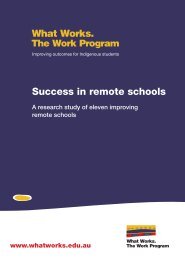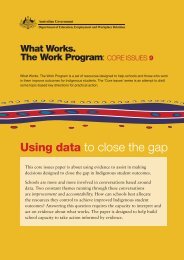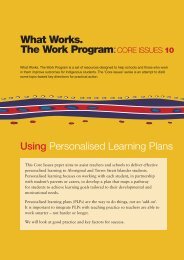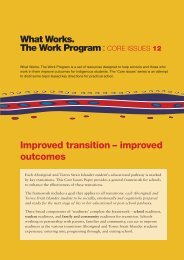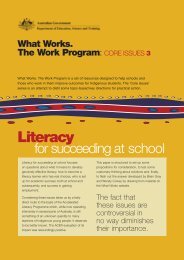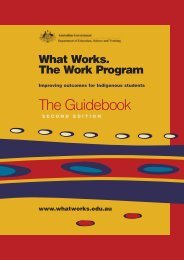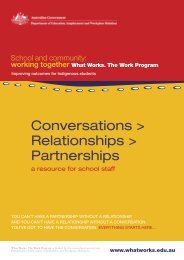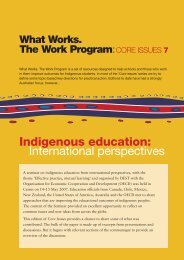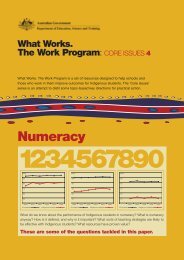Concepts to beconsolidated• Oral vocabulary growth• Phonological awareness• Alphabet knowledge• Letter-sound knowledge• Concept of word in textSPELLINGYear One Year Two Year Three Year Four Year FiveFocused teaching Concepts to be Focused teaching Concepts to be Focused teaching Concepts to be Focused teaching Concepts to be Focused instructionconsolidatedconsolidatedconsolidatedconsolidatedBeginning consonants insingle syllable wordsShort vowel in onset <strong>and</strong>rime patterns in singlesyllable words• at, an, ad, ap, ag• op, ot, og• et, eg, en• ug, ut, un• ip, ig, illDigraphs <strong>and</strong> blends• sh, ch, th, wh• st, sp, sk, <strong>and</strong> sm• sc, sn <strong>and</strong> sw• pl, bl,• cr, cl, fl, fr• bl, br, gr, gl• pr, tr, dr• k, wh, qu, twShort vowels in singlesyllable cvc 1 words• Short a (sad, ham)• Short o• Short i• Short u• Short e (bed, yes)Contractions(I’m, I’ll)Beginning consonants insingle syllable wordsOnset <strong>and</strong> rime patterns(see Year 1 sequence)Digraphs <strong>and</strong> blends(see Year 1 sequence)Short vowels in singlesyllable cvc words(see Year 1 sequence)Short vowels <strong>and</strong> initialdigraphs• (that, ship, when)Short vowels be<strong>for</strong>e –ng, -nt, -nd, -mpCommon long vowelpatterns in single syllablewordsR-influenced vowels insingle syllable wordsor, ar, ir, er, urDiphthongs in simple, singlesyllable wordsConsonant patternsNasal continuants in morecomplex wordsLess common long vowelpatterns• Short i <strong>and</strong> long i (write,might, why)• Long i (wild, find, child)• Long o (told, both, roll,ghost)R-influenced vowel patternsin single syllable words• ar, are, air• er, ear, eer• ir, ire, ier• or, ore, oar• ur, ure, ureW-influenced vowelpatterns• wa (watch, wash), war(warm war), wor (word,work worm)Diphthongs <strong>and</strong> otherambiguous vowel sounds inmore complex words• oi (pointer, enjoy, noise)• oo (soon, good, could)• ou, ow (mountain, brown)Silent beginning consonant• kn, wr, (knife, wrong)Less common long vowelpatternsR influenced vowel patternsDiphthongs <strong>and</strong> otherambiguous vowel sounds• oi (point, enjoy, noise)• oo (soon, good, could)• ou, ow (sound, brown)Silent beginning consonantpatternsknife, wrong,Beginning consonantclustersLess common long vowelpatterns in multi syllablewordsR influenced vowel patternsin multi-syllable wordsDiphthongs in morecomplex words <strong>and</strong> otherambiguous vowel sounds• oy,oi, ou, ow, ould, /u/,ough, au, awSilent beginning consonantpatternsgn, (gnat, gnaw)(wreath, knight)Beginning complexconsonant clustersstraight, throat, screen,squawkDiphthongs <strong>and</strong> otherambiguous vowel soundsin more complex wordsComplex consonant clustersin multi syllable wordsSilent beginning consonantpatternsHard <strong>and</strong> soft c <strong>and</strong> gpatternsdge <strong>and</strong> ge word patternsComplex vowel clusters inmulti syllable wordsSilent beginning consonantpatterns in more complexwords(Knead, knoll, wreath, gnaw)Hard <strong>and</strong> soft c <strong>and</strong> gpatterns in more complexwordsdge <strong>and</strong> ge word patterns inmore complex wordsShort vowels <strong>and</strong> initialblends• (glad, drip, crab)Short vowels <strong>and</strong> finaldigraphs• (cash, rich, much)Short vowels be<strong>for</strong>e ng, nt,nd <strong>and</strong> mp• (rang, went, end, jump)R-influenced vowels insingle syllable words• or, ar, ir, er, urInflectional endingsPlurals <strong>and</strong> past tensemarkerCompound wordsTriple r-blends• scr, str, sprConsonant digraphs• thr, shr, squ(three, shrink, spring)Inflectional endings insingle syllable words• Plural <strong>and</strong> past tense• Three sounds of the pasttense –ed markerCompound words(Inside, beside, itself)Where compound words areprepositions, ensure studentsunderst<strong>and</strong> <strong>and</strong> can ‘act out’the preposition.Hard <strong>and</strong> soft c <strong>and</strong> gpatterns(c<strong>and</strong>le/ centre, garage/giant)dge <strong>and</strong> ge word endings• Short-vowel pattern (edge)• Long vowel patterns (stage)r, l or n indicate ge pattern(large, bulge, range)tch, ch word endingsAs above(catch, reach, porch)Inflectional endings• No change• Doubling• E-dropCompound wordsOpen <strong>and</strong> closed syllablesInflectional endings in morecomplex wordsChanging final y to iMore complex compoundwordsOpen <strong>and</strong> closed syllables• vccv double (supper,dinner)• vcv open (super, diner)• vccv different (window,sister)• vcv closed (river, cover)Vowel patterns in accentedsyllables• Long-a patterns (rainbow,crayon, basement)• Long –i patterns (frighten,ninety, higher)• Long –o patterns (toaster,lonely, owner)• Long –u patterns (cougar,noodle, loser, blue)• Long –e patterns (season,freedom, people)• Long –(y)u patterns(useful, knew, tuber)1C – consonant; V – vowel.<strong>Bound</strong> <strong>for</strong> <strong>Success</strong> <strong>Scope</strong> <strong>and</strong> <strong>Sequence</strong> <strong>Statements</strong> V2 Page 15 Working Document Semester One 2007
SPELLINGYear One Year Two Year Three Year Four Year FiveContractions(I’m, I’ll)Common long-vowelpatterns in single syllablewords• Long a (space, rain)• Long e (seem, clean)• Long o (drove, road)• Long u (cube, food, fruit)Exception to vce pattern –vepattern(give, love, have, dove)Short /e/ sound spelled ea(dead, head, bread)Diphthongsoi/oy (coin, boy)ou/ow (loud/cow)Final /k/ sound spelled ck,ke, k(chick, make, book)Inflectional endings (changefunction of word-number<strong>and</strong> tense)Plurals e <strong>and</strong> esEnsure students underst<strong>and</strong>concept of ‘one’ or ‘morethan one’ be<strong>for</strong>e embarkingon plurals.Past tense endingsExplore the concept of ‘time’as linear. Use timelines,calendars, etc to model <strong>and</strong>rein<strong>for</strong>ce this concept.Compound words(Indoors, breakfast, today)Discuss pronunciationdifferences of words whenused in a compound word egbreak + fast sounds likebreakfastContractions• (It’s, that’s, he’s)• (can’t, didn’t, wasn’t, isn’t)Common homophones(two/to/too; see/sea, of/off)Contractions• It’s, that’s, he’s• can’t, didn’t, wasn’t, isn’tHomophones-simpleContractions – morecomplexHomophones – morecomplex single syllable(break/brake, ate/eight)Meanings of these wordsmust be clearly understood bystudents so they can makeaccurate choices.Inflectional endings• Plurals <strong>and</strong> past tense• Three sounds of the pasttense markerCompound wordsContractionsHomophonesHigh frequency words• Starting with unaccentedsyllable a-• Starting with unaccentedsyllable be-Inflectional endings• No change (walking,asking)• Doubling (stopping)• E-drop (hoping)Unusual past tense words(sleep/slept, keep/kept,shine/shone)Unusual plurals(wife/wives, life/lives)Compound words – morecomplex(butterfly, anthill, seahorse,windmill, dishwasher,bookcase, lightbulb)Contractions in morecomplex words• Verb + not (couldnot/couldn’t)• Word + is (there is/ there’s)• Pronoun + verb (they are/they’re)Introduce concept of open<strong>and</strong> closed syllables• Open syllables end with along vowel sound: tiger,reason• Closed syllables contain ashort-vowel sound that isusually ‘closed’ by 2consonants: rabbit, racketHomophones – singlesyllable• Long –a (pale/pail;hair/hare)• Long –i (write/right;find/fined)Meanings of these wordsmust be clearly understood bystudents so they can makeaccurate choices.Homophones in singlesyllable wordsAmbiguous vowels (Vowelsthat are neither long norshort, thus ambiguous in thecontext of syllable stress)• Oy/oi, ow/ou(voyage,moisture,amount, employ)Vowel patterns inunaccented syllables• Unaccented final syllable(–le spelled le/el/il/al)• Unaccented final syllableer spelled er/ar/or• Unaccented final syllablechur spelled ture, sure(picture, measure)Homophones in two syllablewordsspedal/petal/peddle)Two syllable homographsPRESent/presENTAffixes (introduced as unitsof meaning)• Base word plus simpleprefixes• un, re, dis, mis• Base word plus simplesuffixes• -ful, -ly, -less,- ness• Comparative suffixes–er, -est, -ier, -iestAdding –ion to base words,no spelling change• Base –ct(subtract/subtraction)• Base –ss(express/expression)<strong>Bound</strong> <strong>for</strong> <strong>Success</strong> <strong>Scope</strong> <strong>and</strong> <strong>Sequence</strong> <strong>Statements</strong> V2 Page 16 Working Document Semester One 2007



